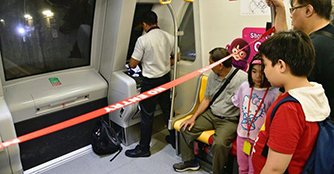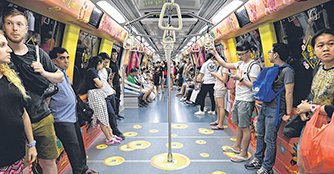Drivers now deployed on Singapore's driverless MRT trains to improve reliability
05 Mar 2018|6,796 views
In a case where humans are still superior to machines, Singapore's driverless MRT lines are now being manned to raise reliability. SBS Transit, which operates the North-East and Downtown lines, told The Straits Times it started manning every North-East Line (NEL) train last October. NEL was the world's first driverless heavy-rail system when it opened in 2003.
SBS Transit spokesman Tammy Tan said it initially manned NEL trains during peak hours and on every other train, but 'we reviewed the arrangements and now we have someone on-board every train throughout operational hours'.
"We have staff on-board our driverless trains not only as a reassurance to commuters, but also for operational contingency," she told The Straits Times, adding that trained staff on board makes for quicker service recovery.
SMRT is also doing the same for the Circle Line - the other driverless MRT system in Singapore. The Straits Times understands the operator - which also runs the manually driven North-South and East-West lines - started putting drivers on-board Circle Line trains in the second half of last year. It will roll this out to all trains on the orbital line soon.
Observers said the manning of driverless trains was one reason why the NEL was the most reliable line in the first three quarters of last year, clocking nearly one million kilometres between technical problems. That is more than twice as reliable as the Circle Line.
A driver on-board a train will be able to, for instance, execute a push-out - using one train to push a disabled one out of the way - immediately. With a driverless system, a driver has to make his way to the unmanned train, which takes time.
As Singapore aims to raise rail reliablity, operators are working hard to find new ways to fix or prevent glitches.
Transport Minister Khaw Boon Wan had set a network-wide target of one million kilometres between problems by 2020 - more than double the current level of reliability.
Mr. Khaw had benchmarked this against Hong Kong's MTR system, which had over 600,000km between breakdowns.
Then, he raised the target, by benchmarking it against the Taipei Metro, which achieved 800,000km between glitches. The metro systems in both countries are largely manned.
An MTR spokesman said, "Among our 10 rail lines plus light rail, only the newly-opened South Island Line and the Disneyland Resort Line - which is basically a shuttle between two stops - have driverless operations."
Mr. Sitoh Yih Pin, Chairman of the Government Parliamentary Committee for Transport, described the manning of driverless trains as a 'prudent step' if it increases reliability and reduces downtime in the event of technical glitches. The move will mean heftier manpower costs for both operators. Neither, however, has ready figures to share.
In a case where humans are still superior to machines, Singapore's driverless MRT lines are now being manned to raise reliability. SBS Transit, which operates the North-East and Downtown lines, told The Straits Times it started manning every North-East Line (NEL) train last October. NEL was the world's first driverless heavy-rail system when it opened in 2003.
SBS Transit spokesman Tammy Tan said it initially manned NEL trains during peak hours and on every other train, but 'we reviewed the arrangements and now we have someone on-board every train throughout operational hours'.
"We have staff on-board our driverless trains not only as a reassurance to commuters, but also for operational contingency," she told The Straits Times, adding that trained staff on board makes for quicker service recovery.
SMRT is also doing the same for the Circle Line - the other driverless MRT system in Singapore. The Straits Times understands the operator - which also runs the manually driven North-South and East-West lines - started putting drivers on-board Circle Line trains in the second half of last year. It will roll this out to all trains on the orbital line soon.
Observers said the manning of driverless trains was one reason why the NEL was the most reliable line in the first three quarters of last year, clocking nearly one million kilometres between technical problems. That is more than twice as reliable as the Circle Line.
A driver on-board a train will be able to, for instance, execute a push-out - using one train to push a disabled one out of the way - immediately. With a driverless system, a driver has to make his way to the unmanned train, which takes time.
As Singapore aims to raise rail reliablity, operators are working hard to find new ways to fix or prevent glitches.
Transport Minister Khaw Boon Wan had set a network-wide target of one million kilometres between problems by 2020 - more than double the current level of reliability.
Mr. Khaw had benchmarked this against Hong Kong's MTR system, which had over 600,000km between breakdowns.
Then, he raised the target, by benchmarking it against the Taipei Metro, which achieved 800,000km between glitches. The metro systems in both countries are largely manned.
An MTR spokesman said, "Among our 10 rail lines plus light rail, only the newly-opened South Island Line and the Disneyland Resort Line - which is basically a shuttle between two stops - have driverless operations."
Mr. Sitoh Yih Pin, Chairman of the Government Parliamentary Committee for Transport, described the manning of driverless trains as a 'prudent step' if it increases reliability and reduces downtime in the event of technical glitches. The move will mean heftier manpower costs for both operators. Neither, however, has ready figures to share.
Latest COE Prices
May 2025 | 2nd BIDDING
NEXT TENDER: 04 Jun 2025
CAT A$102,501
CAT B$116,988
CAT C$63,189
CAT E$118,010
View Full Results Thank You For Your Subscription.





















